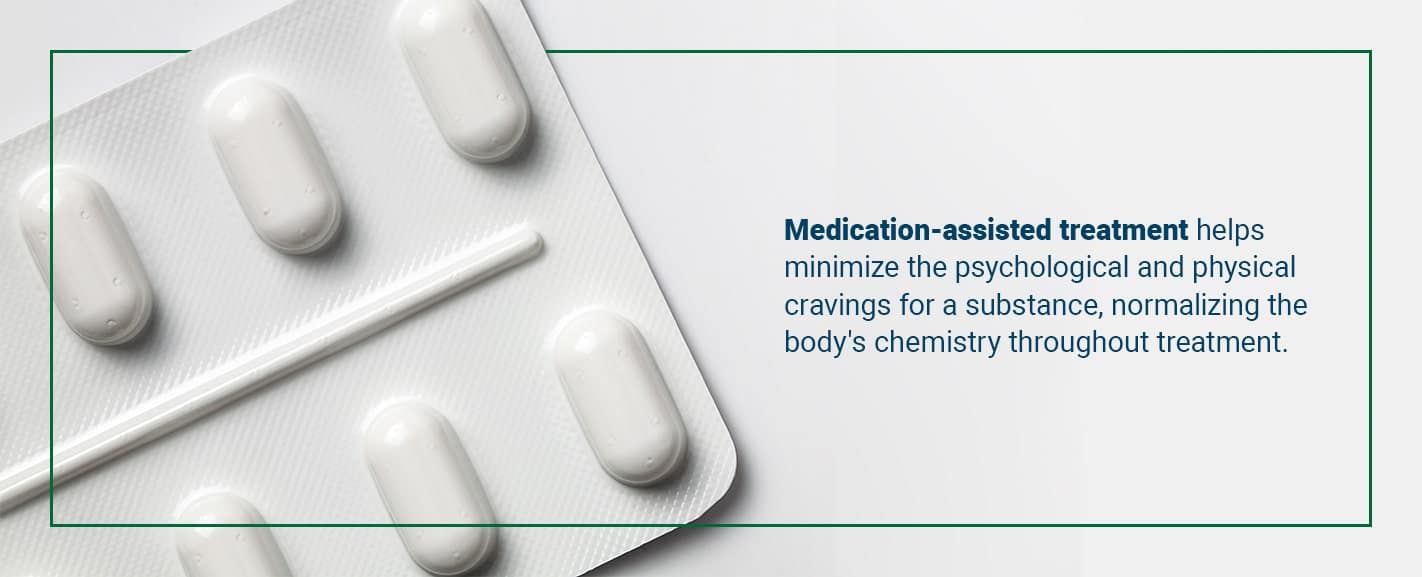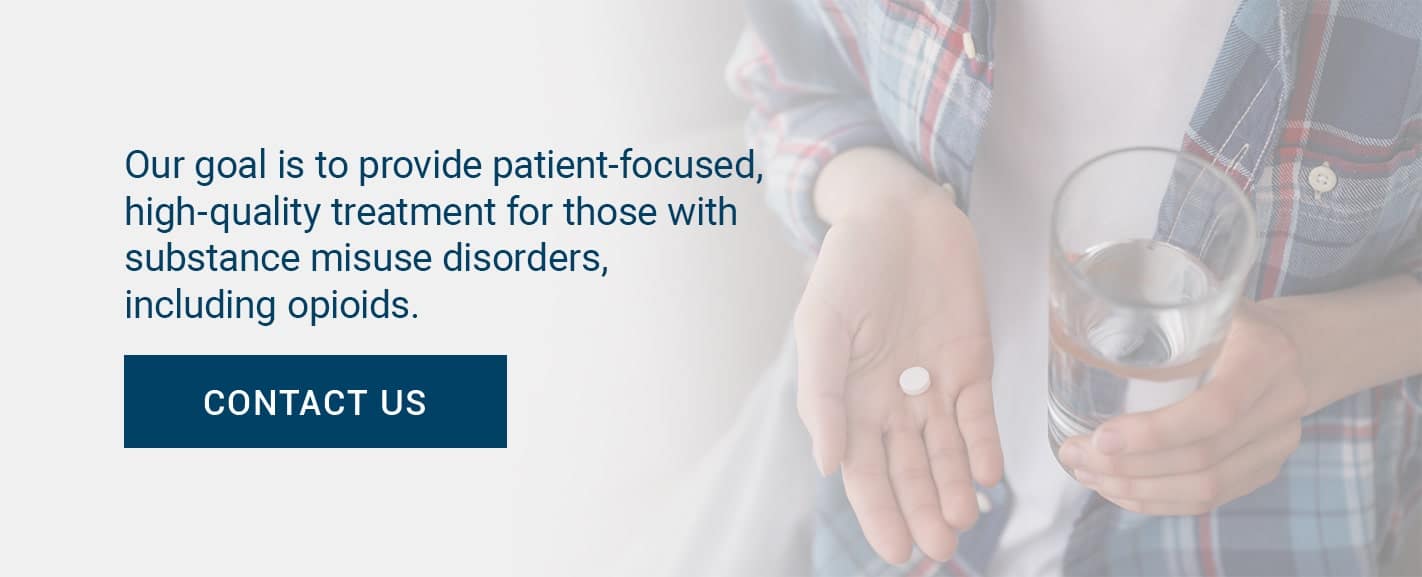Medication-assisted treatment (MAT) is a clinically effective treatment shown to minimize the need for inpatient detoxification. MAT, along with counseling and supportive services, can help patients discontinue substance use in a controlled, safe way.
MAT offers many benefits, including improved retention rates, increased safety and minimized potential overdoses. Learn the difference between MAT vs. withdrawal programs and how medication-assisted treatment can help those with a substance dependency discontinue substance misuse safely.

Benefits of Medication-Assisted Treatment
Medication-assisted treatment combines medication with behavioral therapy and counseling, helping people discontinue substance misuse safely. MAT benefits people looking to treat substance use disorders, especially those dependent on opioids.
MAT is an effective opioid treatment program option with a strong history of success and is endorsed by the National Institutes of Health (NIH), the American Medical Association (AMA) and other organizations. MAT uses medication approved by the Food and Drug Administration (FDA) to block the euphoric effects of substance misuse.
Medication-assisted treatment helps minimize the psychological and physical cravings for a substance, normalizing the body’s chemistry throughout treatment. While MAT is a versatile treatment, it is commonly used to help patients discontinue opioid use. For example, methadone is widely prescribed to assist patients in discontinuing heroin use.
Some of the main benefits of medication-assisted treatment for substance misuse include a safer withdrawal experience that controls cravings and minimizes potentially dangerous symptoms. MAT also reduces the risk of overdose deaths, mitigates relapse risks, and increases treatment retention.

MAT Uses and Medications
MAT is exceptionally effective at helping those with an opioid dependency discontinue use. Currently, the FDA approves three medications for opioid misuse — naltrexone, buprenorphine, and methadone. Each of these medications is effective at helping treat people with opioid substance misuse and dependency. MAT can also help patients who misuse legally prescribed opioids, including morphine, hydrocodone, and oxycodone.
1. Naltrexone
Naltrexone differs from buprenorphine and methadone because it is an opioid antagonist, meaning it blocks the body’s opioid receptors and prevents the euphoric effects. While naltrexone effectively reduces cravings, it is typically only prescribed for approximately seven to 10 days following managed withdrawal.
Another unique aspect of naltrexone is that any licensed medical provider can prescribe this medication. Buprenorphine and methadone require specialized training before a physician can prescribe these medications. Naltrexone can be administered as a long-acting injection or an oral dose daily.
2. Buprenorphine
Buprenorphine helps minimize uncomfortable withdrawal symptoms that commonly affect patients when discontinuing opioid use. A primary benefit of buprenorphine is that it is a more accessible treatment. Patients can receive it from certified and licensed medical providers in community hospitals, health clinics, correctional facilities and other health care departments.
Because buprenorphine is a closely regulated medication, health care providers need to qualify for a waiver to prescribe this medicine. Physicians and medical providers will need training and certification to dispense buprenorphine for opioid misuse.
3. Methadone
Finally, methadone is another effective option for medication-assisted opioid treatment, which dates back to the 1960s, to minimize cravings and withdrawal symptoms. Methadone is only administered under the supervision of a licensed health care provider and can only be dispensed through a certified opioid treatment program.
While methadone is an effective treatment, it can be less accessible due to high demand and low availability. Additionally, patients need to enroll in a certified treatment program to be eligible for methadone treatment, which may not be an option for some people depending on location and other factors.
History of MAT
Treatment for substance misuse goes back many decades, with medication-assisted treatment dating back to the 1930s. Throughout the 20th century, two main types of substance misuse treatment developed, harm reduction or maintenance and total abstinence.
Abstinence-based treatment revolves around completely stopping substance use without medical assistance. Abstinence-based treatments are known as the Minnesota model.
Medication-assisted treatment for opioid addiction emerged as opioid misuse became a widespread problem throughout the United Stated during and after the Civil War, when physicians commonly prescribed opioids to treat pain, stress, and other forms of discomfort.
Unfortunately, historical treatments for opioid misuse often involved physicians prescribing patients additional opioids. Following the Civil War, the nature of opioid misuse and dependency became apparent, and physicians realized they needed to determine appropriate and effective treatments.
The 1920s saw a rise in crime-related opioid activities throughout many cities. In 1929, Congress granted funds to establish two treatment facilities in Fort Worth, Texas, and the other in Lexington, Kentucky. During World War II, many immigrants with pre-existing substance misuse problems moved into the United States and became opioid-dependent. This change also caused many people to view misuse disorders negatively.
Throughout the middle decades of the 1900s, opioid dependency and misuse continued to grow and become more common, especially in large cities. By the 1980s, opioid misuse was running rampant, with young, poor minorities in inner cities hit especially hard. Heroin was the most common opioid being used.
During the 1980s and 1990s, opioid dependency became a major social and medical complication. During the early 1980s, naltrexone was introduced to help those with a substance use disorder discontinue opioid use safely. The success of MAT became apparent through the 1990s and 2000s, leading to the treatment being used across the country.
MAT vs. Withdrawal Programs
Throughout history, many treatments involved abstinence-based methods, which can be risky and lead to higher relapse rates. Discontinuing opioid use “cold turkey” or without intermediate steps can be incredibly dangerous and increases the chance of potentially life-threatening symptoms and complications.
MAT is a safer opioid misuse treatment that helps manage the physical aspects of withdrawal and dependency while minimizing the risk of serious complications and future relapse. While MAT is an effective medical treatment, it is important to note that it is only one aspect of a comprehensive substance misuse treatment.
MAT is often combined with counseling and other forms of supportive therapy to help a person recover from dependence and understand what may have led them to misuse a substance in the first place. Combining these various modalities is the most effective at treating substance misuse.
Medication-assisted treatment requires direct supervision from a medical professional through a licensed program to succeed. MAT is typically offered on an outpatient basis, with short- and long-term treatment and maintenance plans available. The medication used during MAT can better control a person’s opioid receptors.
Our Supporting Resources
One of the most important aspects of a successful opioid dependency treatment is having access to the right information. While it may seem insignificant at first, the resources a person has during treatment can significantly affect the success of treatment. See some of our supporting resources to learn more about how to treat opioid misuse safely:
- Coverage options: BAART programs accept various coverage options, including Medicare.
- Switching programs: If you’ve tried a treatment program that didn’t seem successful, you might have more success switching programs or medications.
- MAT with Suboxone®: Learn more about what to expect from MAT with Suboxone®.
- Treatment misconceptions: Understanding the truth behind misconceptions about MAT can prepare you for treatment.
Find a BAART Programs Location Near You
BAART Programs offer drug treatment services nationwide. We are a multi-service, multi-site organization with over four decades of experience treating opioid use disorders. We are proud to offer supportive, effective recovery services for people all across the country.
Our goal is to provide patient-focused, high-quality treatment for those with substance misuse disorders, including opioids. Our team of experts customizes treatments to meet each patient’s unique needs best and assist them through the various stages of recovery.
Contact us online to learn more about our programs and find a location near you.




